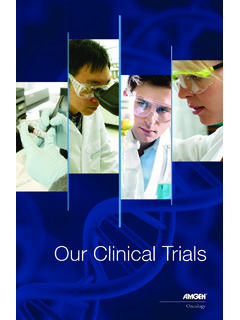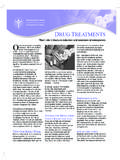Transcription of DRUG NAME: Denosumab - BC Cancer
1 Denosumab drug name : Denosumab SYNONYM(S): COMMON TRADE name (S): XGEVA CLASSIFICATION: monoclonal antibody Special pediatric considerations are noted when applicable, otherwise adult provisions apply. MECHANISM OF ACTION: Denosumab is a human monoclonal antibody that binds to the human RANK ligand (RANKL) on the surface of osteoclasts and their precursors. Denosumab prevents RANKL from binding to RANK, which inhibits osteoclast formation, function and survival, leading to decreased bone loss and destruction. Osteoclast activity is a key mediator of bone disease in metastatic tumours and multiple ,2 PHARMACOKINETICS: Distribution bioavailability 62%; onset 3-7 days2,3; time to peak 10 days (range 3-21 days)3; steady state in 6 months4,5 cross blood brain barrier?
2 No information found volume of distribution no information found plasma protein binding no information found Metabolism degradation to peptides and amino acids in the circulation; hepatic metabolism is not involved6 active metabolite(s) no information found inactive metabolite(s) no information found Excretion renal7 or hepatic6 elimination are not involved urine no information found feces no information found terminal half life2,3 25 - 28 days clearance2,8 faster clearance at lower doses; not affected by weight change Sex no difference Elderly no difference Ethnicity no difference Adapted from standard reference2 unless specified otherwise. USES: Primary uses: Other uses: *Prevention of skeletal-related events from bone metastases from solid tumours *Giant-cell tumour of bone *Hypercalcemia of malignancy *Health Canada approved indication , BC Cancer Agency Cancer drug Manual Page 1 of 8 Denosumab Developed: 1 February 2012 Revised: 1 August 2016 Denosumab SPECIAL PRECAUTIONS: Caution: XGEVA contains the same active ingredient as PROLIA ; they are NOT interchangeable.
3 Formulations differ in concentration, dosing, and ,9 Hypocalcemia may occur with Denosumab ; pre-existing hypocalcemia should be corrected prior to initiating See paragraph following Side Effects table. Osteonecrosis of the jaw (ONJ) has been reported. Patients who have had invasive dental procedures, poor oral hygiene or other periodontal disease may be at risk for ONJ. A dental examination and necessary preventive dentistry is recommended prior to initiating treatment with See paragraph following Side Effects table. Special populations: Denosumab is not recommended for use in pregnant women or in pediatric patients, with the exception of skeletally mature adolescents. Denosumab may impair bone growth in children with open growth plates and may inhibit eruption of Carcinogenicity: Secondary malignancies were reported in 1% of patients in a pooled safety Mutagenicity: No information found.
4 Denosumab is made up of amino acids; therefore, it is unlikely to react with DNA or other chromosomal Fertility: Denosumab had no effect on female fertility or male reproductive organs in animal Pregnancy: FDA Pregnancy Category There is positive evidence of human fetal risk, but the benefits from use in pregnant women may be acceptable despite the risk ( , if the drug is needed in a life-threatening situtation or for a serious disease for which safer drugs cannot be used or are ineffective). In animal studies, Denosumab exposure resulted in increased fetal loss, stillbirths, and postnatal mortality, as well as skeletal abnormalities, impaired bone resorption, reduced bone strength, bone fractures, reduced hematopoiesis, tooth malalignment, dental dysplasia, absent peripheral lymph nodes, and decreased neonatal growth in the Breastfeeding is not recommended due to the potential secretion into breast milk.
5 Pregnant animals also showed altered mammary gland maturation leading to impaired lactation SIDE EFFECTS: The table includes adverse events that presented during drug treatment but may not necessarily have a causal relationship with the drug . Because clinical trials are conducted under very specific conditions, the adverse event rates observed may not reflect the rates observed in clinical practice. Adverse events are generally included if they were reported in more than 1% of patients in the product monograph or pivotal trials, and/or determined to be clinically ,13 ORGAN SITE SIDE EFFECT Clinically important side effects are in bold, italics blood and lymphatic system/ febrile neutropenia anemia (27%) febrile neutropenia (2%) leukopenia (6%) neutropenia (10%) thrombocytopenia (8%) cardiac atrial fibrillation (2%) cardiac failure (2%) , BC Cancer Agency Cancer drug Manual Page 2 of 8 Denosumab Developed: 1 February 2012 Revised.
6 1 August 2016 Denosumab ORGAN SITE SIDE EFFECT Clinically important side effects are in bold, italics tachycardia (3%) eye lacrimation, increased (2%) vision, blurred (2%) gastrointestinal emetogenic potential: rare14 abdominal pain (10%) ascites (2%) constipation (21%) diarrhea (20%) dry mouth (2%) dyspepsia (5%) dysphagia (2%) flatulence (2%) gastritis (2%) gastroesophageal reflux disease (2%) nausea (31%) stomatitis (5%) toothache (4%) general disorders and administration site conditions extravasation hazard: none15 asthenia (21%) chest pain, non-cardiac (9%) edema peripheral (17%) fatigue (27%)2 pain (8%) pyrexia (14%) infections and infestations cellulitis (2%); may lead to hospitalization herpes zoster (2%) oral candidiasis (3%) respiratory tract infection (1%) rhinitis (2%) sinusitis (3%) upper respiratory infection (4%) urinary tract infection (8%) injury, poisoning, and procedural complications contusion (2%) fall (2%) lumbar vertebral fracture (4%) rib fracture (6%) , BC Cancer Agency Cancer drug Manual Page 3 of 8 Denosumab Developed: 1 February 2012 Revised: 1 August 2016 Denosumab ORGAN SITE SIDE EFFECT Clinically important side effects are in bold, italics thoracic vertebral fracture (5%) investigations alkaline phosphatase increase (3%) ALT increase (1%); up to 5 X ULN AST increase (7%); up to X ULN bilirubin, total increase (<1%).
7 Up to 10 X ULN8 creatinine increase (4%) hemoglobin decrease (2%) weight loss (12%) weight gain (2%) metabolism and nutrition dehydration (6%) hypercholesterolemia (7%)8 hyperglycemia (4%) hyperkalemia (2%) hypoalbuminemia (2%) hypocalcemia (10%, severe 3%); see paragraph following Side Effects table hypokalemia (5%) hypomagnesemia (2%) hyponatremia (2%) hypophosphatemia (3 2%, severe 15%) musculoskeletal and connective tissue arthralgia (20%) back pain (25%) bone pain (20%) muscle spasms (4%) muscular weakness (4%) musculoskeletal chest pain (7%) musculoskeletal pain (13%) myalgia (5%) neck pain (4%) osteonecrosis of the jaw (2%)7,16; see paragraph following Side Effects table pain in extremity (18%) pain in jaw (4%) neoplasms secondary malignancies (1%) nervous system dizziness (8%) dysesthesia (4%) dysgeusia (4%) headache (13%) , BC Cancer Agency Cancer drug Manual Page 4 of 8 Denosumab Developed: 1 February 2012 Revised.
8 1 August 2016 Denosumab ORGAN SITE SIDE EFFECT Clinically important side effects are in bold, italics lethargy (2%) paresthesia (6%) peripheral neuropathy (3%) somnolence (2%) spinal cord compression (3%) syncope (2%) psychiatric anxiety (7%) confusional state (3%) depression (7%) insomnia (11%) renal and urinary cystitis (2%) dysuria (4%) hematuria (4%) hydronephrosis (2%) renal failure (3%) urinary retention (4%) reproductive system and breast disorders pelvic pain (3%) respiratory, thoracic and mediastinal cough (15%) dyspnea (21%) epistaxis (4%) hemoptysis (2%) oropharyngeal pain (3%) pleural effusion (5%) pulmonary embolism (2%) respiratory failure (3%) skin and subcutaneous tissue alopecia (9%) erythema (2%) hyperhidrosis (2%) palmar-plantar erythrodysesthesia (4%) pruritus (4%) rash (7%) vascular deep vein thrombosis (2%) hypertension (5%) hypotension (4%) Adapted from standard reference2 unless specified otherwise.
9 , BC Cancer Agency Cancer drug Manual Page 5 of 8 Denosumab Developed: 1 February 2012 Revised: 1 August 2016 Denosumab Hypocalcemia can occur with Denosumab . Some fatalities have been Symptoms include: muscle spasms, twitches, cramps, and numbness or tingling in fingers, toes or around the In severe cases, altered mental status, tetany, seizures, and QTc prolongation have been The serum calcium nadir occurs approximately 10 days after the dose in patients with normal renal ,19 The risk of hypocalcemia is greater in patients with a history of hypoparathyroidism, thyroid surgery, parathyroid surgery, malabsorption syndromes, small bowel surgery, severe renal impairment (creatinine clearance less than 30 mL/min) or on dialysis.
10 Treatment related hypocalcemia may be prevented by supplementing with at least 500 mg calcium daily and 400 IU vitamin D Monitor for hypocalcemia and correct as Osteonecrosis of the jaw (ONJ) is a serious adverse event that may occur spontaneously. Symptoms include: jaw pain, osteomyelitis, osteitis, bone erosion, tooth/periodontal infection or gingival ,6,7 The median time to develop ONJ is 14 ,20 Resolution occurs in 40% of ,7,9,20 ONJ has been associated with dental extraction and/or local infection with delayed healing. If invasive dental procedures are indicated, delay Denosumab treatment until initial bone healing has For further information on the prevention of ONJ during treatment with bone-modifying agents, refer to Bisphosphonates and Osteonecrosis of the Jaw in Oral & Dental Care: Osteonecrosis of the Jaw.














